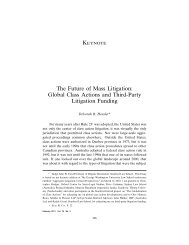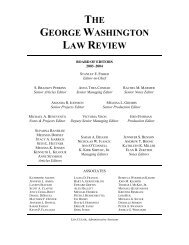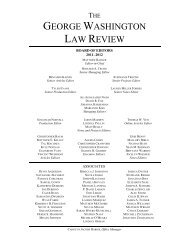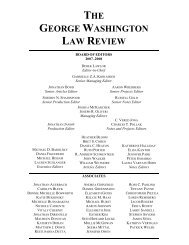View PDF - The George Washington Law Review
View PDF - The George Washington Law Review
View PDF - The George Washington Law Review
You also want an ePaper? Increase the reach of your titles
YUMPU automatically turns print PDFs into web optimized ePapers that Google loves.
2010] Derailing Penn Central 887<br />
claim in Penn Central 103 and the Court of Federal Claims embraced<br />
such a claim in Florida Rock. 104<br />
Because the two cases are so similar with respect to the economic-impact<br />
and investment-backed-expectations factors, the only<br />
explanation for the disparate outcomes must lie in the application of<br />
the character prong. 105 It is likely that many of the Justices understood<br />
the importance of a law preserving such a familiar landmark. 106<br />
On the other hand, the judge in Florida Rock seemed unconcerned<br />
about wetland preservation. 107 Constitutionally protected property<br />
rights should not depend on a court’s subjective view of the interests<br />
advanced by regulation.<br />
A final consideration addressed here is simply that the Supreme<br />
Court has never used the Penn Central test to invalidate state or local<br />
legislation. 108 This could be evidence of the Court’s uncertainty in the<br />
test’s application or could indicate that the test does not provide substantial<br />
protection to landowners. <strong>The</strong> Court’s failure to uphold regulatory<br />
takings claims under Penn Central is problematic for property<br />
owners and demonstrates the need for the Court to use a less vague<br />
and more determinate test.<br />
B. Option Number Two: Embrace Only Lucas and Loretto<br />
This Note has explained that the continued application of Penn<br />
Central is a poor option. One alternative approach is to abandon<br />
103 See Penn Cent., 428 U.S. at 138.<br />
104 See Fla. Rock, 45 Fed. Cl. at 43.<br />
105 It is worth noting that there may be a slight difference in the investment-backed expectations<br />
of the parties in Penn Central and Florida Rock. In Penn Central, “the New York City<br />
law [did] not interfere in any way with the present uses of the Terminal,” Penn Cent., 428 U.S. at<br />
136, whereas in Florida Rock, the regulation prohibited the very purpose for which the plaintiffs<br />
had purchased the land—the extraction of subsurface limestone, Fla. Rock, 45 Fed. Cl. at 25.<br />
106 After Penn Central, “one [was] left with the distinct impression that the Court was persuaded<br />
that historic landmark preservation represented a sound public policy and that this<br />
landmark in particular . . . was worthy of protection.” Echeverria, supra note 25, at 8.<br />
107 Chief Judge Smith admits that the results of the mining operation would technically be<br />
classified as pollution prohibited by the Clean Water Act, but nonetheless appears sympathetic<br />
to the takings claim solely based on the “character of the governmental action.” Fla. Rock, 45<br />
Fed. Cl. at 30, 41. He notes that the concern guiding the denial of the wetland permit is “almost<br />
exclusively the continued existence of the wetland, not the temporary and moderate pollution<br />
incident to the occurrence of actual mining.” Id. at 30 (quoting Fla. Rock Indus., Inc. v. United<br />
States, 791 F.2d 893, 904 (Fed. Cir. 1986)). Echeverria believes that “[t]he Court of Federal<br />
Claims’s conclusion that the wetlands were not worth saving seems as squarely based on personal<br />
opinion as the Supreme Court’s conclusion that Grand Central Terminal was worth saving.”<br />
Echeverria, supra note 25, at 8.<br />
108 See Stewart E. Sterk, <strong>The</strong> Federalist Dimension of Regulatory Takings Jurisprudence, 114<br />
YALE L.J. 203, 251–56 (2004).









